
Welcome to portlandsnakes.com! I am David, a snake enthusiast living in Portland, OR. Many people don't know that Portland is in fact full of snakes! You just need to know where to find them - they can often be shy and elusive. Some Oregon snake species are more common outside of the city limits, in different parts of Multnomah County OR, but many types of snakes are indeed common in the more urban parts of Portland. This guide is meant to help educate you about the beautiful snakes of Portland, and to help you identify the most common snakes of Portland, as well as the venomous snakes of Portland that you should learn to recognize and avoid. If you want more detail, click here for my complete list of ALL snake species in Portland. Remember the following:
- Most snakes of Portland are harmless and don't want to encounter you
- Venomous snakes exist but are uncommon in Portland, Oregon
- Snakes eat rats and mice and are a valuable part of the Oregon ecosystem
- Never kill a snake - if you leave a snake alone, it will leave you alone.
Common Snake Species in Portland
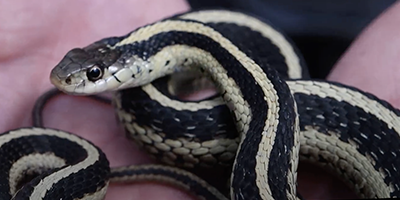 Common Garter Snake:
The common garter snake (Thamnophis Sirtalis) is found throughout North America everywhere from the northeast, southeast, to the more northern western states, and the west coast. Their habitat is diverse, ranging from forests to fields, prairies, streams, wetlands, marshes, and ponds. They are found at elevations from sea level to mountains. In urban and suburban areas, they can be found in basements, gardens, debris piles, and areas with standing water. Their saliva contains a mild venom that is not toxic to humans but may cause some slight itching, burning, or swelling. They are not considered venomous for human beings.
Common Garter Snake:
The common garter snake (Thamnophis Sirtalis) is found throughout North America everywhere from the northeast, southeast, to the more northern western states, and the west coast. Their habitat is diverse, ranging from forests to fields, prairies, streams, wetlands, marshes, and ponds. They are found at elevations from sea level to mountains. In urban and suburban areas, they can be found in basements, gardens, debris piles, and areas with standing water. Their saliva contains a mild venom that is not toxic to humans but may cause some slight itching, burning, or swelling. They are not considered venomous for human beings.Common garter snakes are thin and about 22 inches in length. They typically have a pattern of yellow stripes on a brown, black, or green background, however, common garter snakes have been found with a wide variety of colors, including blue, gold, orange, and red. It is diurnal and tends to be most active in the morning and late afternoon. They are sometimes seen basking in the sun on a particularly warm winter afternoon.
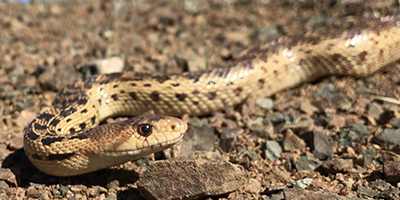 Pacific Gopher Snake:
The Pacific gopher snake (Pituophis catenifer) is found throughout the west coast of the United States. Their natural habitat ranges from woodlands, arid deserts, grassy meadows, and prairies. They can be found in suburban areas that encroach on their natural habitat. They are not venomous but do inflate their bodies, flatten their heads, and shake their tails when threatened. This produces a sound similar to the rattle of rattlesnakes.
Pacific Gopher Snake:
The Pacific gopher snake (Pituophis catenifer) is found throughout the west coast of the United States. Their natural habitat ranges from woodlands, arid deserts, grassy meadows, and prairies. They can be found in suburban areas that encroach on their natural habitat. They are not venomous but do inflate their bodies, flatten their heads, and shake their tails when threatened. This produces a sound similar to the rattle of rattlesnakes. The Pacific gopher snake has a base color ranging from yellow to dark brown with gray coloring on the side of the body. They have dark brown spots. The adults can grow from 3 to 7 feet in length, with 4 to 5 being the average. They get their name from a favorite prey- pocket gophers. They also eat birds and their eggs, other small mammals, reptiles, and insects.
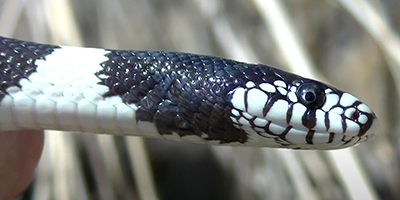 California Kingsnake:
The California kingsnake (Lampropeltis Californiae) is found throughout the western United States and northern Mexico. It can be found in the mountains to an elevation of 6,100 feet. It has adapted to a wide range of habitats, including grasslands, deserts, marshes, woodland chaparrals, and suburban areas. They are non-venomous.
California Kingsnake:
The California kingsnake (Lampropeltis Californiae) is found throughout the western United States and northern Mexico. It can be found in the mountains to an elevation of 6,100 feet. It has adapted to a wide range of habitats, including grasslands, deserts, marshes, woodland chaparrals, and suburban areas. They are non-venomous.The California kingsnake comes in a wide variety of colors, black and brown being common, and they usually have black/brown or white/tan stripes. Their average length is two feet but they have been known to grow to a little more than three feet. They “smell” using their forked tongue and Jacobson organ to taste and analyze scent particles. They are constrictors and feed by squeezing and suffocating prey.
Venomous Snake Species in Portland
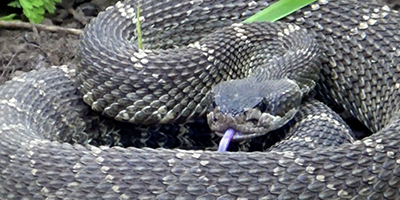 Northern Pacific Rattlesnake:
The northern Pacific rattlesnake (Crotalus oreganus) can be found in western North America from the Baja peninsula in California, up through the west coast and into the south of British Columbia. It can also be found in western and southern Idaho, Nevada, Wyoming, Utah, Arizona, and New Mexico. They have adapted to a wide variety of habitats, including deserts, arid plains, fertile valleys, prairie grasslands, rocky ridges, mountain meadows, and forests. They are venomous.
Northern Pacific Rattlesnake:
The northern Pacific rattlesnake (Crotalus oreganus) can be found in western North America from the Baja peninsula in California, up through the west coast and into the south of British Columbia. It can also be found in western and southern Idaho, Nevada, Wyoming, Utah, Arizona, and New Mexico. They have adapted to a wide variety of habitats, including deserts, arid plains, fertile valleys, prairie grasslands, rocky ridges, mountain meadows, and forests. They are venomous. The northern Pacific rattlesnake has a range of potential colors from dark-brown, dark-gray, olive-brown, black, or pale yellowish ground color. They have a pattern of uneven, dark blotches with uneven white edges. They usually have a pale-yellow belly with brown spots and a dark-brown blotch on the snout. They can reach 39 inches in length. They tend to come out during dawn and dusk and are nocturnal in the heat of summer. They like to stay hidden during the day but will sometimes come out to bask on the rocks.
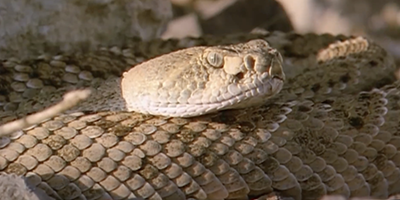 Western Rattlesnake:
The western rattlesnake (Crotalus Viridis) is a pit viper that can be found from southwestern Canada, along the west coast and western United States, and down to northern Mexico. They are found in habitats ranging from the Great Plains to the foothills of the Rocky Mountains. They are found in the following states: California, Oregon, Washington, Idaho, Colorado, Montana, the Dakotas, Nebraska, Kansas, Texas, New Mexico, and Arizona. They go where there is a prey base and they like vegetation cover. They can occupy rocky (or cement) outcroppings and are known to take over burrows that other animals make. They are poisonous.
Western Rattlesnake:
The western rattlesnake (Crotalus Viridis) is a pit viper that can be found from southwestern Canada, along the west coast and western United States, and down to northern Mexico. They are found in habitats ranging from the Great Plains to the foothills of the Rocky Mountains. They are found in the following states: California, Oregon, Washington, Idaho, Colorado, Montana, the Dakotas, Nebraska, Kansas, Texas, New Mexico, and Arizona. They go where there is a prey base and they like vegetation cover. They can occupy rocky (or cement) outcroppings and are known to take over burrows that other animals make. They are poisonous. Western rattlesnakes are typically lightly colored in shades of brown. They have patches of dark brown with uneven edges. They have a triangle-shaped head with pit sensory organs on either side and a distinctive pair of internasals connecting the rostral. They average about three feet in length. They feed on birds, mice, rats, and small mammals such as prairie dogs, and occasionally on reptiles and amphibians.
If you're unsure, you can email me a photo of the snake at info@portlandsnakes.com and I will email you back with the snake's species. If you found a snake skin, read my Found a Skin? page, and you can email me a photo of the skin, and I'll identify the snake for you. If you need professional Portland snake removal help, click my Get Help page, or see the below website sponsor I found, who provides that service.
Does Lime or Sulfur Keep Snake Away?
A lot of people will not be happy with the idea of sharing their space with the snake. Therefore, before it even happened, they would implement some preventive measures to avoid a snake invasion. However, some people will use a random homemade repellent solution found over the internet, such as lime and sulfur. Unfortunately, there are some reasons why these items will not be effective against snake infestation.
Is Lime an Effective Repellent Against Snake?
A lot of DIY guides on the internet will tell you that lime would be a practical way to deter snake invasion. While this may sound like a very convenient idea, there are no existing studies that will prove the efficacy of the lime against snake activities. Lime is a substance found on a hill's soil; you can also see a mineral buildup of lime around the drain of your bathroom area. Several studies have already been performed, and all of them show that lime does not have the power to drive away the snake.
Additionally, you should be aware of the hazards related to lime. You can be putting your loved ones at risk by using this as a repellent. Once the item becomes wet, it will become corrosive that will lead to severe burns. Lime has often been the culprit of skin burns among kids. Therefore, it will not just be ineffective, but it is also dangerous to your pets and family.
Is Sulfur Effective in Driving the Snake Away?
Sulfur is another DIY repellent that you will find over the internet. Reading the articles about its ability to deter snake invasion may sound convincing and promising. However, this can be quite farther from the truth. There is absolutely nothing about sulfur that will drive away the snake. According to the researchers at the Pennsylvania University, using sulfur against snakes will be a total waste of your money. There are even videos on YouTube that show that a product containing sulfur is ineffective against the serpent.
What is the Better Way to Get Rid of the Snake?
The best preventive measure against snakes is to make your place less desirable in the eye of the animal. Regularly trim down your lawn and remove the clutters in your area. Any pile of leaves and rocks are possible hiding ground of the snake. If you have a rodent infestation in your place, you need to solve it. Snakes love the taste of the rodents, and they will be attracted to the scent of these animals.
Finally, if a snake is already inside your property, respect its space. This reptile is a shy and solitary creature. They will immediately flee when they encounter us rather than to confront us. Also, you should ask the help of a professional for the removal and exclusion process. Experts can go directly to the root cause of the problem to prevent snake reinfestation. Remember not to approach the snake, especially if you do not know how to identify the snake species.
Remember, the term is not poisonous snakes of Portland, it's venomous snakes of Portland. Poison is generally something you eat, and venom is injected into you. That said, dangerous snakes are very rare in Portland. The few venomous snakes of Multnomah County are rarely seen. But they are commonly misidentified, so learn about all the snake species of Portland in order to correctly identify them. These snakes are usually also found in the surrounding towns of Portland, Gresham, Troutdale, Wood Village, Fairview, Maywood Park, and the surrounding areas.
Read our article about:
Natural Enemies of the Snake
portlandsnakes.com domain and hosting costs made possible by the generous support of this sponsor:
